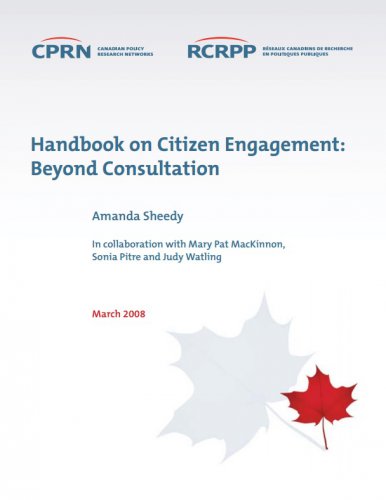This handbook builds on years of work at the Canadian Policy Research Networks bringing together cutting edge thinkers and practitioners in the field of citizen engagement. While it is not possible to capture all of CPRN’s and others’ work in one handbook, the hope is that this tool will provide a good overview of the breadth of the field – both the concepts and the methods – and supply ample resources (particularly online resources) with which to deepen knowledge on specific subjects.
The handbook is intended to whet the appetite for citizen engagement for those new to citizen engagement, and for those with experience to deepen the analysis behind citizen engagement projects and provide a synthesis of the field and a concise reference tool. The long term vision is to contribute to the closing of the gap between governments and citizens, to allow public servants and politicians to reconnect with citizens’ needs, priorities and values.
This handbook is not a prescriptive how-to manual on citizen engagement. There is no one-sizefits-all in citizen engagement. Each context, policy or program development process requires a unique approach and adapted tools to address its specific needs. Engaging citizens in a meaningful way first requires an understanding of the philosophy and vision of citizen engagement. It calls for planning and preparation and sometimes institutional capacity building. It can demand a shift in organizational or departmental cultural conceptions of what citizens can bring to a policy process. This handbook is a starting point to think about these issues and a reference guide for those who wish to deepen their understanding and practice of citizen engagement.
Citizen engagement is premised on the belief that people should have and want to have a say in the decisions that affect their lives. While some may claim that voting and consultation processes achieve this, it is clear that citizens are increasingly frustrated with these democratic mechanisms. They feel that their voices are not being heard and that decisions made by elites do not necessarily reflect their values. Citizen engagement provides a vision for a way forward – a way of reinvigorating current democratic practices and institutions, bringing meaning to people’s participation and fostering a two way dialogue between citizens and governments. The hope is that this will not be seen as a mechanism for placating peoples’ desires, but actually bring about a more just society where governments’ choices more closely reflect the needs of its population.
Download the Handbook on Citizen Engagement
Contents
| Chapter I. Introduction | |||
| a) Purpose of the handbook | |||
| b) Intended audience | |||
| c) How this handbook was developed | |||
| d) How to use the handbook | |||
| Chapter II. What Is Citizen Engagement? | |||
| a) What citizen engagement is, and what it is not | |||
| b) Beyond consultations and voting: citizen engagement and the renewal of representative democracy | |||
| c) An introduction to the frameworks for citizen engagement | |||
| Chapter III. Why Citizen Engagement? | |||
| a) The climate in Canada and the need for democratic renewal | |||
| b) The hopes and fears of citizen engagement | |||
| Chapter IV. Institutionalizing Citizen Engagement | |||
| Chapter V. Engaging Members of Specific Populations | |||
| Chapter VI. Engaging Aboriginal Communities | |||
| Chapter VII. Getting Started | |||
| a) Preparation | |||
| 1. Determine goals and rationale, plus assess context | |||
| 2. Assessing citizen engagement requirements | |||
| b) Designing the process | |||
| 1. Developing internal capacity: new roles and responsibilities | |||
| 2. Framing the issue in public terms | |||
| 3. Recruitment: random, purposive or self-selective | |||
| 4. Logistics: time, place and other considerations | |||
| 5. Choosing methods to match goals | |||
| 6. Consider online citizen engagement | |||
| 7. Providing credible information to support citizens’ participation | |||
| 8. Facilitators/moderators | |||
| 9. Planning for evaluation and analysis | |||
| 10. Reporting to decision-makers and participants | |||
| c) Implementation | |||
| Chapter VIII. Case Examples | |||
| a) Involve | |||
| 1. | Vancouver Coastal Health’s Community Health Advisory Committees | ||
| 2. | The Romanow Commission on the Future of Health Care in Canada | ||
| 3. | The Subcommittee on the Status of Persons with Disabilities of the Standing Committee on Human Resources Development and the Status of Persons with Disabilities | ||
| b) Collaborate | |||
| 4. | Toronto Community Housing Corporation’s Tenant Participation System | ||
| c) Empower | |||
| 5. | Ontario Citizens’ Assembly on Electoral Reform | ||
| Chapter IX. Practical Tips | |||
| Endnotes | |||
| Appendix A. An Overview of Public Participation Methods | |||
| Figures and Tables | |||
| Figure 1. VCH Community Engagement Framework | |||
| Table 1. Three Levels of Involvement | |||
| Table 2. Clarifying the Definition of Citizen Engagement | |||
| Table 3. IAP2 Public Participation Spectrum | |||
| Table 4. Health Canada’s Public Involvement Continuum | |||
| Table 5. Barriers to Participation and Potential Solutions | |||
| Table 6. Key Conditions for Success | |||
| Table 7. Roles and Responsibilities to Consider | |||
| Table 8. Framework for Selection of Engagement Techniques | |||
| Table 9. Challenges and Opportunities of Online Citizen Engagement | |||
Format
Theme





